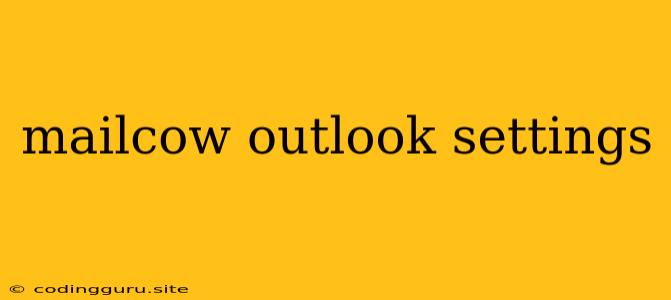Setting Up Mailcow with Outlook
Setting up Mailcow to work seamlessly with Microsoft Outlook can be a great way to manage your email on your own server. Here's a comprehensive guide to walk you through the process:
Before you begin:
- Mailcow installation: Ensure you have Mailcow installed and configured on your server.
- Outlook version: The steps might slightly differ based on your Outlook version (2016, 2019, or Outlook for Windows/Mac).
- Mailcow Configuration: You need to have the necessary mail accounts created in Mailcow.
Step 1: Accessing Mailcow Web Interface
- Open your web browser and navigate to the Mailcow web interface URL. This is usually
https://yourdomain.com/mailcow. - Log in: Use your administrator credentials to log in to Mailcow.
Step 2: Setting up Mailcow Account in Outlook
-
Open Outlook and go to File > Add Account.
-
Choose "Manually configure server settings or additional server types" and click Next.
-
Select "POP or IMAP" and click Next.
-
Fill in the account information:
- Your Name: Your name as you want it to appear in Outlook.
- Email Address: Your full email address (e.g., [email protected]).
- Account Type: Choose IMAP for the best experience (POP can be used if required).
- Incoming Server: This will be
imap.yourdomain.com(replaceyourdomain.comwith your actual domain name). - Outgoing Server (SMTP): This will be
smtp.yourdomain.com(replaceyourdomain.comwith your actual domain name). - Port:
- IMAP: 993 (with SSL/TLS enabled)
- SMTP: 465 (with SSL/TLS enabled) or 587 (with STARTTLS enabled).
- Username: Your full email address.
- Password: Your email password.
- Check "Remember password" if you want Outlook to store your password.
-
Click "More Settings" to access additional options:
- Outgoing Server (SMTP) tab:
- Check "My outgoing server (SMTP) requires authentication".
- Select "Use the same settings as my incoming mail server".
- Advanced tab:
- Incoming Server (IMAP): Set "This server requires a secure connection (SSL)" and choose port 993.
- Outgoing Server (SMTP): If using port 465, choose "This server requires a secure connection (SSL)" and enable port 465. If using port 587, choose "This server requires a secure connection (TLS)" and enable port 587.
- Outgoing Server (SMTP) tab:
-
Click "Next" and "Finish" to complete the setup.
Step 3: Testing the Connection
- Send a test email to yourself from Outlook. This ensures that the connection is working correctly.
Troubleshooting Tips:
- Check your Mailcow settings: Ensure the ports and authentication settings are correctly configured in your Mailcow settings.
- Firewall settings: Double-check that your firewall isn't blocking the required ports for IMAP and SMTP.
- Domain DNS settings: Verify your domain's DNS records for MX, A, and CNAME records are set up correctly to point to your Mailcow server.
- SSL/TLS certificates: Make sure your Mailcow server is using valid SSL/TLS certificates.
- Password: Verify you are using the correct password for your mail account.
Security Considerations:
- Enable two-factor authentication (2FA) for your Mailcow account for enhanced security.
- Use strong passwords: Avoid simple or easily guessable passwords.
- Keep your Mailcow and Outlook software updated: Updates often include security patches.
Conclusion:
Setting up Mailcow with Outlook allows you to enjoy the advantages of a self-hosted email solution. By carefully following the steps above, you can access your mail directly from your Outlook client while maintaining control over your data. Always remember to prioritize security measures and keep your software updated for optimal performance and protection.
